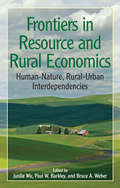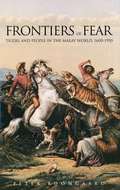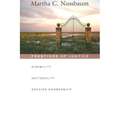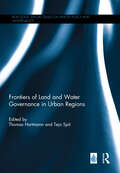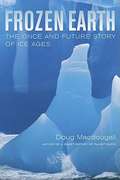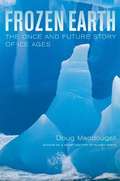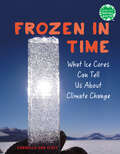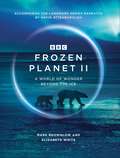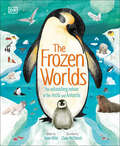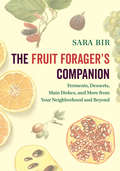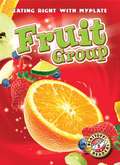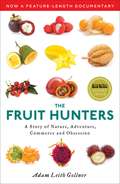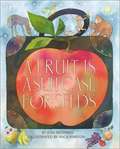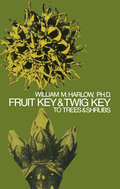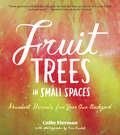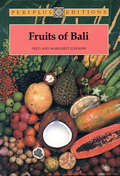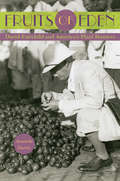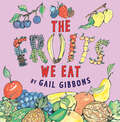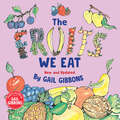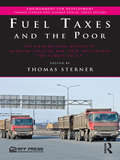- Table View
- List View
Frontiers in Resource and Rural Economics: "Human-Nature, Rural-Urban Interdependencies"
by Wu JunJie Paul W Barkley Bruce A WeberMost land in the United States is in rural areas, as are the sources of most of its fresh water and almost all its other natural resources. One of the first books to approach resource economics and rural studies as fundamentally interconnected areas of study, Frontiers in Resource and Rural Economics integrates the work of 18 leading scholars in resource economics, rural economics, rural sociology and political science in order to focus on two complex interdependencies-one pertaining to natural resources and human welfare, the other to urban and rural communities and their economies. The book reviews the past 50 years of scholarship in both natural resource and rural economics. It contrasts their different intellectual and practical approaches and considers how they might be refocused in light of pressing demands on human and natural systems. It then proposes a 'new rural economics' that acknowledges the full range of human-ecosystem and urban-rural interdependencies. It explores the relationship between natural resources and economic growth, and considers the prospects for amenity-driven growth that would benefit both new and traditional inhabitants of rural areas. Later chapters explore the politics of place, spatial economics, strategies for reducing rural poverty, and prospects for linking rural and environmental governance. Throughout, the book emphasizes innovative research methods that integrate natural resource, environmental, and rural economics.
Frontiers of Fear: Tigers and People in the Malay World, 1600-1950
by Peter BoomgaardThis book is about the relation between humans and the three big cats of the Malay world: the tiger, the leopard, and the clouded leopard. Above all, however, it is about the tiger.It is difficult to be neutral about tigers. They seem to elicit either strongly positive or strongly negative sentiments, and it is even possible (and far from rare) that one person has both positive and negative feelings about tigers.
Frontiers of Justice: Disability, Nationality, Species Membership
by Martha C. Nussbaumgeneral and the timeless. Yet such theories, addressing the world and its problems, must respond to the real and changing dilemmas of the day. A brilliant work of practical philosophy, Frontiers of Justice is dedicated to this proposition. Taking up three urgent problems of social justice neglected by current theories and thus harder to tackle in practical terms and everyday life, Martha Nussbaum seeks a theory of social justice that can guide us to a richer, more responsive approach to social cooperation.<P><P> The idea of the social contract--especially as developed in the work of John Rawls--is one of the most powerful approaches to social justice in the Western tradition. But as Nussbaum demonstrates, even Rawls's theory, suggesting a contract for mutual advantage among approximate equals, cannot address questions of social justice posed by unequal parties. How, for instance, can we extend the equal rights of citizenship--education, health care, political rights and liberties--to those with physical and mental disabilities? How can we extend justice and dignified life conditions to all citizens of the world? And how, finally, can we bring our treatment of nonhuman animals into our notions of social justice? Exploring the limitations of the social contract in these three areas, Nussbaum devises an alternative theory based on the idea of "capabilities." She helps us to think more clearly about the purposes of political cooperation and the nature of political principles--and to look to a future of greater justice for all.
Frontiers of Land and Water Governance in Urban Areas (Routledge Special Issues on Water Policy and Governance)
by Thomas Hartmann and Tejo SpitA society that intensifies and expands the use of land and water in urban areas needs to search for solutions to manage the frontiers between these two essential elements for urban living. Sustainable governance of land and water is one of the major challenges of our times. Managing retention areas for floods and droughts, designing resilient urban waterfronts, implementing floating homes, or managing wastewater in shrinking cities are just a few examples where spatial planning steps into the governance arena of water management and vice versa. However, water management and spatial planning pursue different modes of governance, and therefore the frontiers between the two disciplines require developing approaches for setting up governance schemes for sustainable cities of the future. What are the particularities of the governance of land and water? What is the role of regional and local spatial planning? What institutional barriers may arise? This book focuses on questions such as these, and covers groundwater governance, water supply and wastewater treatment, urban riverscapes, urban flooding, flood risk management, and concepts of resilience. The project resulted from a Summer School by the German Academy for Spatial Research and Planning (ARL) organized by the editors at Utrecht University in 2013.This book was published as a special issue of Water International.
Frosty: A Raccoon to Remember
by Harriet E. WeaverIn this warm and joyous book, Harriet E. Weaver, for 20 years the only lady ranger in California’s Big Basin Redwood Park, tells the story of life with an orphan raccoon named Frosty, an impish, intelligent and irresistibly charming creature of the wilds. Appropriate for children, but enjoyable by all ages...
Frozen Adventures: Looking at Glaciers Around the World (Fountas & Pinnell Classroom, Guided Reading Grade 6)
by M. E. ReidNIMAC-sourced textbook
Frozen Earth: The Once and Future Story of Ice Ages
by Doug MacdougallIn this engrossing and accessible book, Doug Macdougall explores the causes and effects of ice ages that have gripped our planet throughout its history, from the earliest known glaciation--nearly three billion years ago--to the present. Following the development of scientific ideas about these dramatic events, Macdougall traces the lives of many of the brilliant and intriguing characters who have contributed to the evolving understanding of how ice ages come about. As it explains how the great Pleistocene Ice Age has shaped the earth's landscape and influenced the course of human evolution, Frozen Earth also provides a fascinating look at how science is done, how the excitement of discovery drives scientists to explore and investigate, and how timing and chance play a part in the acceptance of new scientific ideas. Macdougall describes the awesome power of cataclysmic floods that marked the melting of the glaciers of the Pleistocene Ice Age. He probes the chilling evidence for "Snowball Earth," an episode far back in the earth's past that may have seen our planet encased in ice from pole to pole. He discusses the accumulating evidence from deep-sea sediment cores, as well as ice cores from Greenland and the Antarctic, that suggests fast-changing ice age climates may have directly impacted the evolution of our species and the course of human migration and civilization. Frozen Earth also chronicles how the concept of the ice age has gripped the imagination of scientists for almost two centuries. It offers an absorbing consideration of how current studies of Pleistocene climate may help us understand earth's future climate changes, including the question of when the next glacial interval will occur.
Frozen Earth: The Once and Future Story of Ice Ages
by Douglas MacdougallDoug Macdougall explores the causes and effects of ice ages that have gripped our planet throughout its history, from the earliest known glaciations -- nearly three billion years ago -- to the present.
Frozen Earth: The Once and Future Story of Ice Ages
by Douglas MacdougallAn accessible account of the nature and global effects of Ice Ages, including the history of how several maverick scientists developed various pieces of our current scientific theory of these times, and how recent studies of Pleistocene climate may help us understand Earth's future climate changes.
Frozen in Time: What Ice Cores Can Tell Us About Climate Change (Books for a Better Earth)
by Carmella Van VleetA dazzling introduction to paleoclimatology for kids, connecting the methods that scientists use to study our climate history with future climate change solutions.Believe it or not, ice isn&’t always just frozen water. In fact, most of the ice covering our planet contains thousands of years' worth of information about our atmosphere. This ice is made up of a lot more than snow—it has soot, volcanic ash, gasses, and other substances that affect the climate. And if we drill a piece of that ice? We get a frozen time capsule, courtesy of Earth. In this exhilarating middle grade nonfiction book by a former educator, kids are immersed in the field of paleoclimatology. Readers go along on an ice core expedition, run through each step in the collecting and transporting process, review the fascinating components of an ice core, and explore the specialized labs where scientists examine them.But these pieces of our planet are more than just cool records. By preserving and studying these frosty collections of climate history, we can learn from previous patterns and better protect our planet in the future. The final chapter focuses on ice as a key tool in the fight against climate change.With crystal-clear explanations and an engaging, kid friendly tone, the book features 15+ full-color photographs, diagrams, interviews with paleoclimatologists, a glossary of terms, and simple experiments for budding scientists at home. Books for a Better Earth are designed to inspire children to become active, knowledgeable participants in caring for the planet they live on.A Junior Library Guild Gold Standard Selection
Frozen Planet II
by Mark Brownlow Elizabeth WhiteACCOMPANIES THE LANDMARK SERIES NARRATED BY DAVID ATTENBOROUGHFind a world of wonder beyond the ice. 'Looking down at our planet from space it may come as a surprise how much of it is blanketed in snow and ice. These vast frozen wildernesses cover more than a fifth of the earth ... From the highest peaks to snow-bound deserts to alien worlds deep beneath the ice, they are home to an astonishing array of animals found nowhere else on earth.'David Attenborough, from the series.Frozen Planet II celebrates the surprisingly diverse worlds of ice - a world that is disappearing before our very eyes. Previously undiscovered stories, from chameleons giving birth on the frosty slopes of Mount Kenya to endangered Amur leopards in the Russian forest and killer whales hunting Weddell seals on ice floes in the Antarctic, shed new light on the beauty and the peril of the world's most fragile ecosystems. Behind-the-scenes insights explore the unique challenges of filming in these frozen worlds, where camera crew and wildlife alike brave the extreme conditions.With over 250 stunning full-colour photographs, Frozen Planet II reveals the wonders of the fastest-changing part of our planet, as we may never see them again.
The Frozen Worlds: The Astonishing Nature of the Arctic and Antarctic (The Magic and Mystery of the Natural World)
by Jason BittelEnter the world of the Arctic and Antarctic, in this gorgeously illustrated book for young animal and conservation enthusiasts.Polar bears and penguins glide and whales and walruses dive across the pages of this colorful book, which takes children on a fascinating sub-zero journey of the amazing Earth&’s poles.The Frozen Worlds combines stunning illustrations and photos to help young enthusiasts aged 7-9 learn all about the Arctic and Antarctic. From incredible frozen rivers to Antarctic volcanoes, they&’ll discover the incredible secret life of Earth&’s polar regions, as well as which plants and animals live near them, and how they can protect them from the issues facing them today. Children will love finding out all about the different people who live and work here, and how they can help take care of the Arctic and Antarctic themselves.This fascinating book for children features: - Intriguing information about the Arctic and Antarctic, that supports and goes beyond the curriculum!- Factual, fascinating, and fun content - with detailed illustrations and photographs of animals, icebergs, and more.- An engaging mixture of stunning photography and detailed illustrations by Claire McElfatrick.- Exciting and unusual facts convey information about our amazing polar regions.The Frozen Worlds covers a wide range of exciting subjects about the polar regions, from their wildlife to their geography and history, including a multitude of polar life, amazing facts on how icebergs are formed, how animals survive in the freezing cold, and how scientists study the Antarctic. Children with an interest in the Earth&’s icy poles will love reading about the ecosystems, habitats and climates in these fascinating regions.
The Fruit Forager's Companion: Ferments, Desserts, Main Dishes, And More From Your Neighborhood And Beyond
by Sara BirFrom apples and oranges to pawpaws and persimmons Half of the fruit that grows in yards and public spaces is never picked or eaten. Citrus trees are burdened with misshapen lemons, berries grow in tangled thickets on the roadside, and the crooked rows of abandoned orchards fill with fallen apples. At the same time, people yearn for an emotional connection that’s lacking in bland grocery store bananas and tasteless melons. The Fruit Forager’s Companion is a how-to guide with nearly 100 recipes devoted to the secret, sweet bounty just outside our front doors and ripe for the taking, from familiar apples and oranges to lesser-known pawpaws and mayhaws. Sara Bir—a seasoned chef, gardener, and forager—primes readers on foraging basics, demonstrates gathering and preservation techniques, and presents a suite of recipes including habanero crabapple jelly, lime pickle, pawpaw lemon curd, and fermented cranberry relish. Bir encourages readers to reconnect with nature and believes once the foraging mindset takes control, a new culinary world hiding in plain sight will reveal itself. Written in a witty and welcoming style, The Fruit Forager’s Companion is a must-have for seekers of both flavor and fun.
Fruit Group
by Megan Borgert-SpaniolRelevant images match informative text in this introduction to the fruit group. Intended for students in kindergarten through third grade
The Fruit Hunters: A Story of Nature, Adventure, Commerce, and Obsession
by Adam Leith GollnerDelicious, lethal, hallucinogenic and medicinal, fruits have led nations to war, fueled dictatorships and lured people into new worlds. An expedition through the fascinating world of fruit, The Fruit Hunters is the engrossing story of some of Earth's most desired foods. In lustrous prose, Adam Leith Gollner draws readers into a Willy Wonka-like world with mangoes that taste like piña coladas, orange cloudberries, peanut butter fruits and the miracle fruit that turns everything sour to sweet, making lemons taste like lemonade. Peopled with a cast of characters as varied and bizarre as the fruit -- smugglers, inventors, explorers and epicures -- this extraordinary book unveils the mysterious universe of fruit, from the jungles of Borneo to the prized orchards of Florida's fruit hunters to American supermarkets. Gollner examines the fruits we eat and explains why we eat them (the scientific, economic and aesthetic reasons); traces the life of mass-produced fruits (how they are created, grown and marketed) and explores the underworld of fruits that are inaccessible, ignored and even forbidden in the Western world. An intrepid journalist and keen observer of nature -- both human and botanical -- Adam Leith Gollner has written a vivid tale of horticultural obsession.
A Fruit Is a Suitcase for Seeds
by Jean RichardsA description of seed dispersal by which plants, most specifically fruits, travel from one place to another.
Fruit Key and Twig Key to Trees and Shrubs
by William M. HarlowThese handy, accurate, and easily used keys to fruit and twig identification are the only guides of their sort with photographs -- over 350 of them, of nearly every twig and fruit described -- making them especially valuable to the novice.The fruit key (dealing with both deciduous trees and evergreens) begins with a concise introduction, explaining simply and lucidly the process of seeding, and identifying the various organs involved: the cones and flowers, and their component parts and variations. Next the various types of fruits are described -- drupe, berry, pome, legume, follicle, capsule, achene, samara, nut -- and fruiting habits, followed by a synoptic summary of fruit types.The introduction to the twig key tells in plain language the process of growth and its relation to twig morphology through leaf scars, branch scars, buds, etc. For the benefit of the unwary, poison-ivy, poison-oak and poison-sumac are immediately and fully described.Identification in both books is easy. There is a pair of alternative descriptions of each aspect of the specimens. Your choice of the fitting one leads you automatically to the next proper pair. At the end of the chain is the name of your specimen and, as a double check, a photograph. More than 120 different fruits and 160 different twigs are distinguished.This exceptional work, widely used in university courses in botany, biology, forestry, etc., is a valuable tool and instructor to the naturalist, woodsman, or farmer, and to anyone who has wondered about the name of a leafless tree in winter or been intrigued by an interestingly shaped fruit or seed.
Fruit Trees in Small Spaces: Abundant Harvests from Your Own Backyard
by Colby EiermanLuscious peaches, crisp apples, and sweet plums right off the tree are hard to beat. For gardeners yearning for the pleasures of home-grown fruit plucked straight from the tree, this deliciously encouraging guide cuts the subject down to size. Colby Eierman, garden designer and fruit expert, shows how trees can easily be tucked into the tiniest spots and still yield a bumper crop of gorgeous fruit. Fruit Trees in Small Spaces covers everything a gardener needs to know about choosing and nurturing the most delicious small-space varieties, including selection, pruning, training, irrigation, and disease prevention. With inspiring ideas for spaces of all shapes and sizes and creative recipes for your incredible harvest, you'll want to plant a mini-orchard in every intimate corner. For the gardener with space limitations, bountiful fruit trees are now within arm's reach.
Fruits of Bali
by Fred B. Eiseman Margaret EisemanBali's Succulent Tropical Fruits make a vivid ans lasting impression on every visitor. Fruits of Bali is a field guide to this cornucopia of exotic shapes, tastes, and smells - providing photographs and descriptions of some 50 varieties, as well as fascinating botanical and background information and tips on buying and preparing the fruits yourself. Even familiar fruits acquire a distinct taste and texture in the island's tropical environment, and those unique to the region provide a surprising and delicious experience.
Fruits of Bali
by Fred B. Eiseman Margaret EisemanBali's Succulent Tropical Fruits make a vivid ans lasting impression on every visitor. Fruits of Bali is a field guide to this cornucopia of exotic shapes, tastes, and smells - providing photographs and descriptions of some 50 varieties, as well as fascinating botanical and background information and tips on buying and preparing the fruits yourself. Even familiar fruits acquire a distinct taste and texture in the island's tropical environment, and those unique to the region provide a surprising and delicious experience.
Fruits of Eden: David Fairchild and America's Plant Hunters
by Amanda HarrisAt the turn of the nineteenth century—when most food in America was bland and brown and few people appreciated the economic potential of then-exotic foods—David Fairchild convinced the U.S. Department of Agriculture to finance overseas explorations to find and bring back foreign cultivars. Fairchild traveled to remote corners of the globe, searching for fruits, vegetables, and grains that could find a new home in American fields and in the American diet.In Fruits of Eden, Amanda Harris vividly recounts the exploits of Fairchild and his small band of adventurers and botanists as they traversed distant lands—Algeria, Baghdad, Cape Town, Hong Kong, Java, and Zanzibar—to return with new and exciting flavors. Their expeditions led to a renaissance not only at the dinner table but also in horticulture, providing diversity of crops for farmers across the country.Not everyone was supportive, however. The scientific community was concerned with invasive species, and World War I fanned the flames of xenophobia in Washington. Adversaries who believed Fairchild’s discoveries would contaminate the purity of native crops eventually shut down his program, but his legacy lives on in today’s modern kitchen, where navel oranges, Meyer lemons, honeydew melons, soybeans, and durum wheat are now standard.
The Fruits We Eat
by Gail GibbonsBerries, apples, melons, and grapes; oranges, grapefruits, bananas -- yum! This scrumptious picture book, a companion to The Vegetables We Eat, offers youngsters an inviting, information-packed cornucopia of favorite fruits. Gail Gibbons combines a clear, simple text with her signature illustrations to present fruit facts galore: the parts of fruits, where and how they grow, harvesting, processing, where to buy them, and how to enjoy them as part of a healthy diet.
The Fruits We Eat (New & Updated)
by Gail GibbonsFrom #1 science writer for kids Gail Gibbons, learn everything about the delicious fruits you eat with this new and updated edition.Berries, apples, melons, and grapes; oranges, grapefruits, bananas -- yum! This scrumptious, updated picture book, a companion to The Vegetables We Eat, offers youngsters an inviting, information-packed cornucopia of favorite fruits.Gail Gibbons combines a clear, simple text with her signature illustrations to present fruit facts galore: the parts of fruits, where and how they grow, harvesting, processing, where to buy them, and how to enjoy them as part of a healthy diet.
¡Fuego! ¡Fuego! (¡Arriba la Lectura!, Level E #30)
by Beverley Randell Yishan Li¡Auxilio! ¡Auxilio! ¡Hay un incendio! Un helicóptero se lleva a la familia Pardo. Pero el gatito Misu se escapa. ¿Estarán a salvo Misu y la casa? NIMAC-sourced textbook
Fuel Taxes and the Poor: The Distributional Effects of Gasoline Taxation and Their Implications for Climate Policy (Environment For Development Ser.)
by Thomas SternerFuel Taxes and the Poor challenges the conventional wisdom that gasoline taxation, an important and much-debated instrument of climate policy, has a disproportionately detrimental effect on poor people. Increased fuel taxes carry the potential to mitigate carbon emissions, reduce congestion, and improve local urban environment. As such, higher gasoline taxes could prove to be a fundamental part of any climate action plan. However, they have been resisted by powerful lobbies that have persuaded people that increased fuel taxation would be regressive. Reporting on examples of over two dozen countries, this book sets out to empirically investigate this claim. The authors conclude that while there may be some slight regressivity in some high-income countries, as a general rule, fuel taxation is a progressive policy particularly in low income countries. Rich countries can correct for regressivity by cutting back on other taxes that adversely affect poor people, or by spending more money on services for the poor. Meanwhile, in low-income countries, poor people spend a very small share of their money on fuel for transport. Some costs from fuel taxes may be passed on to poor people through more expensive public transportation and food transport. Nevertheless, in general the authors find that gasoline taxes become more progressive as the income of the country in question decreases. This book provides strong arguments for the proponents of environmental taxation. It has immediate policy implications at the intersection of multiple subject areas, including transportation, environmental regulation, development studies, and climate change. Published with Environment for Development initiative.
